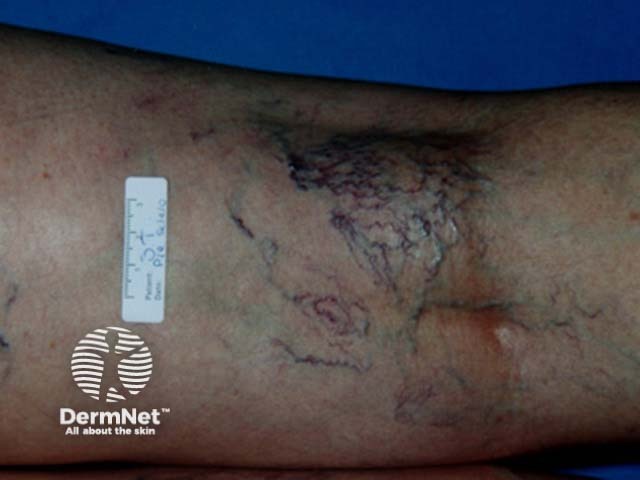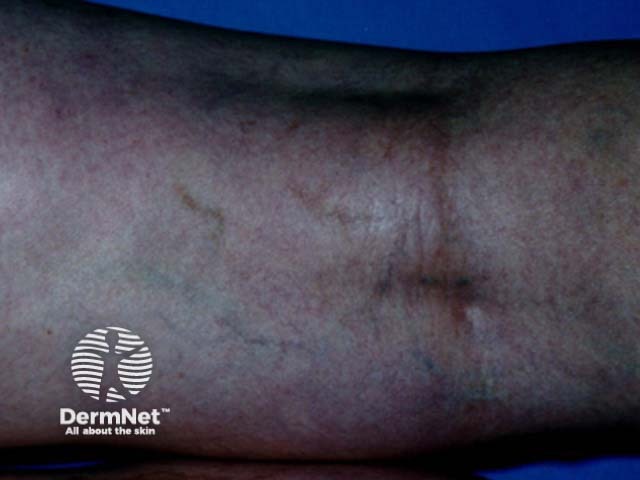Main menu
Common skin conditions

NEWS
Join DermNet PRO
Read more
Quick links
Sclerotherapy — extra information
Treatments Blood vessel problems
Sclerotherapy
Author: Author: Dr Amanda Oakley, Dermatologist, Waikato Hospital, 2003.
What is sclerotherapy?
Sclerotherapy is an injection technique used to get rid of veins. Most often it is used to treat leg veins, but it may also be used for venous malformation, or blue vessels on the sides of the nose and elsewhere.
No anaesthetic is required. A strong solution (the sclerosant) is injected directly into the blood vessel causing inflammation of the walls of the vessel. The vessel disappears over a few weeks to months.
Microsclerotherapy, using a tiny needle, is the best way to treat venulectasia (blue veins) on the legs.
Larger varicose veins may also be treated by sclerotherapy especially if they are tortuous or recurrent (endovenous laser treatment may be preferred for straight veins or on the first occasion). First, a Duplex ultrasound scan should be performed to map out the path of superficial, perforator and deep veins. Those greater than 5 mm in width and demonstrating reflux are the most suitable for treatment. Sclerotherapy of larger superficial veins and perforator vessels is usually performed with ultrasound (echo) guidance. Best results are achieved using a foam sclerosant, where the sclerosant solution is mixed with air in a ratio of 1:4 to form minute bubbles. This provides a greater volume to push the blood away so the sclerosant may adhere more effectively to the blood vessel wall.
Arteries are not treated by sclerotherapy.
Thread veins before and after treatment with sclerotherapy

Before treatment

After sclerotherapy

Staining
Sclerosants
Sclerosant chemicals include:
- Hypertonic saline (20% NaCl i.e. strong salt solution)
- Sodium tetradecyl sulphate
- Polidocanol.
Repeated treatments may be necessary at six- to twelve-weekly intervals to achieve up to 85% success at three years.
Although each session may involve a large number of injections, the needle used is very fine so that pain is not generally a problem. There may be some stinging as the solution travels through the smaller vessels. These become red and slightly swollen, sometimes itchy for a few hours.
Aftercare
Often cotton wool pads under adhesive plasters are applied to the injection sites. Pressure is applied to the treated vessels using Grade 2 graduated compression hosiery (support stockings) and/or bandages. These are usually worn for between seven days and three weeks following each treatment. They come in different sizes and colours.
Patients are usually able to return to normal daytime activities immediately after sclerotherapy. They should walk for at least thirty minutes a day, especially for the first few days following the procedure. Vigorous physical activities such as weight lifting or aerobics classes are not advised during this time.
What are the complications of sclerotherapy?
In most cases, the pain, discomfort and swelling associated with the veins disappear within days, and the vessels slowly resolve over several months. Serious complications following sclerotherapy are rare.
- Allergy from the sclerosant (this does not occur with hypertonic saline).
- Ulceration. This will eventually heal leaving a small scar or may be removed surgically. If an artery is inadvertently treated, the surrounding tissue may die (necrose), which is potentially serious.
- Deep venous thrombosis. The risk is very small when venules are treated but it occasionally follows sclerotherapy of larger varicose veins. It is more likely in those predisposed to blood clotting through inherited thrombophilia, lack of exercise, air travel, after major operations and other reasons. Deep venous thrombosis may rarely lead to potentially serious pulmonary emboli (clots in the blood vessels of the lungs) in about 1 in every ten thousand procedures.
The following side effects occur more frequently.
- Staining or brown pigmentation, at the site or along the line of the vein. This occurs in about 30% of patients. In most cases, this resolves but it may take many months.
- Clots within treated vessels (superficial thrombophlebitis). These are not dangerous but can be quite tender if they occur in the larger veins. They can be removed through a needle prick after several weeks if necessary, but left alone they will eventually be reabsorbed.
- Temporary bruising. Bruises at the injection sites are quite common but resolve within a week or so.
- Capillary matting. This is an increase in the number of fine red vessels around the injection site; it may disappear on its own or can be treated by further injections or a vascular laser.
Very fine vessels may be too small to inject, in which case a vascular laser or intense pulsed light treatment may be worth trying.
On DermNet
Other websites
- Varicose Veins and Spider Veins — Medscape Reference
Books about skin diseases
